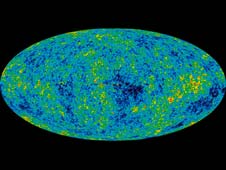READ: Cosmic Microwave Background Radiation
Cosmic Microwave Background Radiation

This image is the detailed, all-sky picture of the infant universe created from seven years of WMAP data. The image reveals 13.7 billion year old temperature fluctuations (shown as color differences) that correspond to the seeds that grew to become the galaxies. Image courtesy of NASA.
Since the cosmic microwave background was first discovered in 1964, the science of cosmology — the study of the origin and structure of the universe — has significantly advanced. As the oldest light that we can see, the cosmic microwave background is a subject of great interest to scientists and continues to be studied, most notably with information provided by two satellite observatories: the Cosmic Background Explorer (COBE) and the Wilkinson Microwave Anisotropy Probe (WMAP).
The cosmic microwave background is a snapshot of how the universe looked at a very young age. Just after the Big Bang, the early universe would have been so hot and dense that matter could exist only as free electrons and nuclei. These free particles would continually scatter all photons of light throughout the universe, making the universe opaque (dark). About 380,000 years after the Big Bang, the universe had expanded and cooled to about 3,000 K (degrees Kelvin), which allowed atoms to form. Due to the presence of atoms rather than free particles, photons of light were less scattered and the universe became transparent to radiation. Since then, the universe has continued to expand and cool, and the light that existed when the young universe first became transparent have been stretched along with the expansion of space. This light is now seen as the radiation of the cosmic microwave background.
COBE, launched in 1989, was the first mission to detect slight fluctuations in the almost completely uniform distribution of the cosmic microwave background. The results of WMAP have offered support for the Big Bang theory and given further insight into the conditions of the early universe. Scientists have found that the universe is about 13.7 billion years old and that there was likely a period of rapid expansion just after the Big Bang. They have also learned that the early universe had variations in the density of matter — seen in the fluctuations of the cosmic microwave background — that eventually led to the formation of galaxies and to the large-scale structure of the universe that we see today. In addition, findings indicate that the geometry of the universe is flat and that it will continue to expand forever.
The data collected from COBE and WMAP about the existence of cosmic microwave background radiation is another key piece of evidence scientists use to support the expansion of the universe and the Big Bang Theory.
Source:
After you have completed this part of the lesson, you can check the box for this lesson piece in the course to mark it as complete